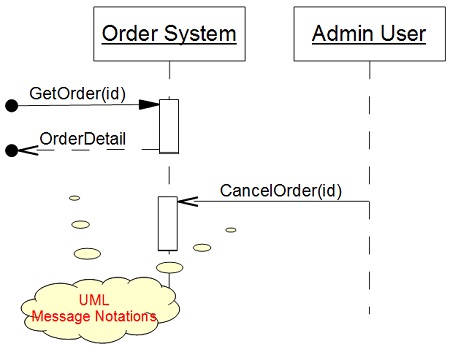UML Tutorials - Herong's Tutorial Examples - v1.05, by Herong Yang
Sequence Diagram - Message Notation
This section describes the Message Notation used in a UML Sequence Diagram. A Message Notation represents a particular communication between objects participating a communication interchange.
A Message Notation is a graphical notation used in a UML Sequence Diagram to represent a particular communication between objects participating a communication interchange.
A Message Notation is drawn as a straight line with an arrow pointing to the lifeline which receives the message. The style of the line and arrow have 3 variations depending on whether or not the message is synchronous message:
- Asynchronous Message - The sender of the message is not waiting for any return messages. An asynchronous message is represented by a solid line with a line arrow.
- Synchronous Request Message - The sender of the message is waiting for a return message. A synchronous request message is represented by a solid line with a solid arrow.
- Synchronous Response Message - The sender of the message is responding to a synchronous message it received earlier. Synchronous Response is represented by a dash line with a line arrow.
A Message Notation should be draw from the lifeline of the sender to the lifeline of the receiver. If the sender or receiver is unknown or simply outside of the scope of the diagram, a small solid circle should used:
- Found Message - The sender of the message is unknown. A found message is represented by adding a small solid circle at the sender side of the line.
- Lost Message - The receiver of the message is unknown. A lost message is represented by adding a small solid circle at the receiver side of the line.
A Message Notation may have a label to provide message name and arguments. An order may support 2 message calls: A synchronous message call of GetOrder(id) and an asynchronous call of CancelOrder(id). These message calls can be drawn as Message Notations in a UML sequence diagram as shown below:

Table of Contents
Introduction of UML (Unified Model Language)
UML Class Diagram and Notations
UML Activity Diagram and Notations
►UML Sequence Diagram and Notations
Sequence Diagram - Lifeline Notation
►Sequence Diagram - Message Notation
Sequence Diagram - Execution Specification Notation
Sequence Diagram - Frame Notation
UML State Machine Diagram and Notations
UML Use Case Diagram and Notations